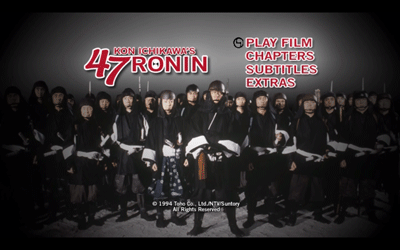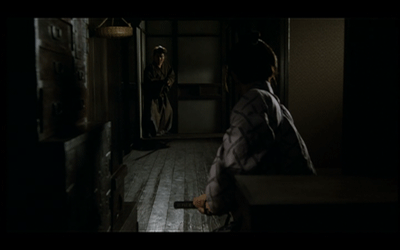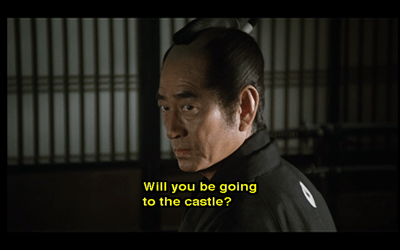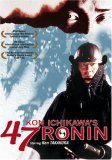| Reviews & Columns |
|
Reviews DVD TV on DVD Blu-ray 4K UHD International DVDs In Theaters Reviews by Studio Video Games Features Collector Series DVDs Easter Egg Database Interviews DVD Talk Radio Feature Articles Columns Anime Talk DVD Savant Horror DVDs The M.O.D. Squad Art House HD Talk Silent DVD
|
DVD Talk Forum |
|
|
| Resources |
|
DVD Price Search Customer Service #'s RCE Info Links |
|
Columns
|
|
|
Kon Ichikawa's 47 Ronin
THE MOVIE:

As Bugs Bunny might say, "You can't tell a player without a program."
The 47 Ronin, also known as Chushingura, has been adapted to motion pictures more than eighty times. Based on a true story, it's part of the fabric of Japan's national mythology, much like stories about George Washington attacking the Hessians in the Revolutionary War is a part of the U.S. fabric. The most famous of these films are by Kenji Mizoguchi (also director of Sansho the Bailiff) and Hiroshi Inagaki (the Samurai trilogy), made in 1941 and 1962, respectively. Legendary director Kon Ichikawa (Tokyo Olympiad, The Burmese Harp) tackled the story in 1994, and it's what is being released on DVD now as Kon Ichikawa's 47 Ronin.
For the first half an hour of Ichikawa's production, most of your attention is likely going to be focused on trying to sort out who is who, what has upset them, and what they are going to do about it. Not only are characters introduced in an extremely quick fashion, but voice-over narration informs us of the history behind their clans and other elements of social background the writer/director thinks we should know. Creating further confusion under the guise of helping are the added cultural notes provided by AnimEigo on this DVD. Appearing at the top of the screen while the dialogue runs past on the bottom, you may want to sit with your finger on the pause button in order to catch everything. I also started a flow chart to keep track of the main players. It's worth mentioning that at one point I put info about one character in the wrong column and had to circle it and put an arrow pointing to the right spot. It's that confusing. Shakespeare's Henry plays have less history, and there's like four of them!
Here's the basic plot: Lord Asano of the Ako clan attacked Sir Kira of the Uesegi clan for reasons unknown to everyone but the two of them. Thanks to machinations by the manipulative Irobe, who has designs to grab both men's power, Asano is forced to commit ritual suicide and his fiefdom is abolished. Convinced that his family has been unfairly shafted, Chamberlain Oishi (Ken Takakura) gathers the forty-seven most loyal of the Ako samurai to plot revenge on Kira. Mindful of what a successful plot could mean to his bid for glory, Irobe compels Kira to build an impenetrable mansion and lock himself away. Undeterred, Oishi and his men breach their walls and instigate a violent brawl.
On paper, it sounds like the recipe for a bloodbath. As a film, however, Kon Ichikawa's 47 Ronin is a lot dryer than the body count would suggest. It takes nearly two hours to get to the big fight, and by that point, only twenty minutes are left. Though there are a couple of good skirmishes in the chaos of the battle, it's largely impersonal and without complicated choreography or fanfare. My favorite part is when the Ako ronin have sake and rice balls delivered to them at the Kira mansion, and they stop to refuel. That's wartime etiquette!
In a lot of action movies, the build-up to the battle is often just as interesting, if not moreso, than the battle itself. (To use Shakespeare again, Henry V is a good example.) This usually requires characters we can invest our time in, however, something Kon Ichikawa's 47 Ronin sorely lacks. It's all about the information, and yet it feels like I'm watching a chess game and no one will tell me what those little pieces are. What's the horse? What's the castle? What are all those little things with the round head? I don't know!
Ichikawa does have one central character, and that's Oishi. When the film is watchable, it's because Ken Takakura is onscreen. He has the most at stake: he's leading the charge, while simultaneously having to settle the affairs of his immediate family and deal with the new affair he has with a young girl. He's a man torn between the finale of his life and the promises of a new beginning. Will he die, or will he restore the honor of his clan and start a new family? A highly respected Japanese actor seen most recently in Zhang Yimou's Riding Alone for Thousands of Miles, Takakura has a commanding presence that controls whatever scene he is in, even if he's just sitting and saying nothing. If we stayed with him the entire time, Kon Ichikawa's 47 Ronin would be a different movie. It's all the other complications of plot and the attempts to introduce us to the various other fighters that bogs the production down.
For all those complaints, though, I will say that the final confrontation between Oishi and Kira is riveting. Cutting between this encounter and the original incident between Kira and Asano, Ichikawa does drive home what all of the other business hinged on. The end is the beginning is the end, as it were. It's nearly enough to redeem all the head scratching and yawning that came before...but not quite.

THE DVD
Video:
Kon Ichikawa's 47 Ronin has been put on DVD at a 16:9 aspect ratio in anamorphic widescreen. The picture quality is so-so. The darker scenes are patchy, and you will see some edge enhancement and ghosting. Most of the colors look good and there is no surface noise, so it's really just an issue of resolution.
Sound:
A Dolby audio track of the original Japanese is clean and easy to hear. The subtitles in English are well written but a bit of a marathon to keep up with. As noted in the main review, there are often two sets of subtitles to read at once. Up top, in white, you get notes about what is going on while down below you get the main dialogue. The down-below dialogue is mainly in yellow. At other times, the font switches to green and once or twice even pink to help differentiate when multiple people are speaking. This can help when the speech is moving so fast, the dialogue of two different characters will appear on screen simultaneously.
Put on your running shoes, though. There are many key scenes in Kon Ichikawa's 47 Ronin that are pretty tough to keep up with. The words come flying at you without any mercy, and you may need to pause or back up and try to catch it again.
Extras:
Program notes are given as slideshow collections of title cards. They are broken into three categories: Cast/Crew/Awards, About the Film, Historical Notes, and Program Notes. "About the Film" actually explains the full history of the story and provides a list of other productions, while "Program Notes" are those explanatory subtitles from the movie collected in one place. Much better would have been to have them on paper in the package so they'd be accessible to us during the film, but this is what we've been given.
There is also a gallery of color and black-and-white stills, and a couple of promo posters. Trailers for this film and Ichikawa's Dora Heita are included, as well.
FINAL THOUGHTS:
I like samurai films and I like Kon Ichikawa, but the writer/director's 1994 version of The 47 Ronin is a tedious run-through of history that gets bogged down in the details, making it short on character and action. It's not that the story can't be compelling--other directors have done fine with it--but this one is dry to the point of being parched. Still, a good performance by revered Japanese actor Ken Takakura and a well-done climax do warrant at least a look. A less-than-stellar DVD, however, prohibits purchasing it. Rent It.

Jamie S. Rich is a novelist and comic book writer. He is best known for his collaborations with Joelle Jones, including the hardboiled crime comic book You Have Killed Me, the challenging romance 12 Reasons Why I Love Her, and the 2007 prose novel Have You Seen the Horizon Lately?, for which Jones did the cover. All three were published by Oni Press. His most recent projects include the futuristic romance A Boy and a Girl with Natalie Nourigat; Archer Coe and the Thousand Natural Shocks, a loopy crime tale drawn by Dan Christensen; and the horror miniseries Madame Frankenstein, a collaboration with Megan Levens. Follow Rich's blog at Confessions123.com.
|
| Popular Reviews |
| Sponsored Links |
|
|
| Sponsored Links |
|
|
| Release List | Reviews | Shop | Newsletter | Forum | DVD Giveaways | Blu-Ray | Advertise |
|
Copyright 2024 DVDTalk.com All Rights Reserved. Legal Info, Privacy Policy, Terms of Use,
Manage Preferences,
Your Privacy Choices | |||||||













